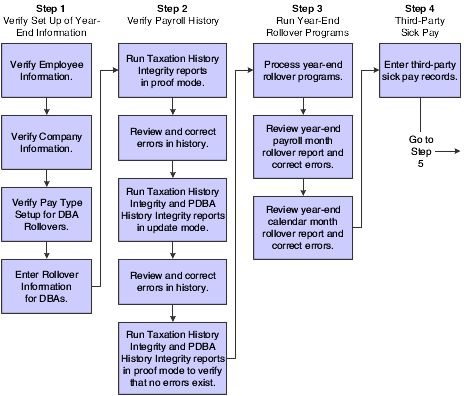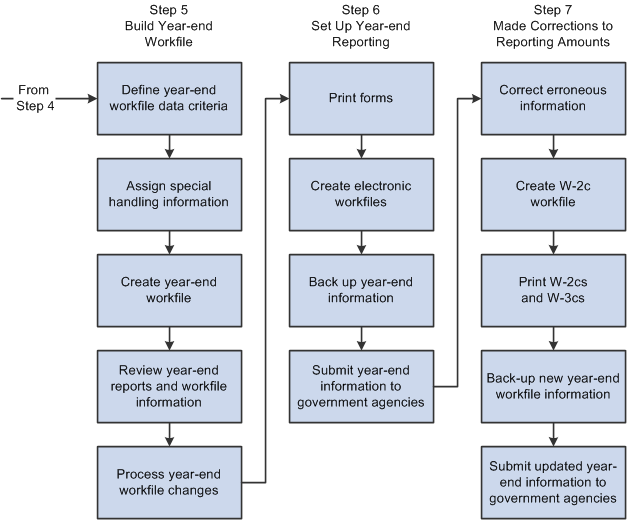The U.S. Payroll Year-End Processing Cycle
The U.S. Payroll Year-End Processing cycle consists of these tasks:
Install the update.
You must install the update to run year-end programs. The update contains changes that comply with the most current government legislation.
Perform these steps:
Install the U.S. Payroll Year-End Processing software for the current year.
Complete the post-installation instructions for the update.
This guide does not discuss software installation and the necessary post-installation instructions.
See the installation documentation that accompanied the software update. For installing the current-year software update contact technical Upgrade Object Management (UOM).
Verify payroll history.
Review the Taxation History Integrity Report (R077011), the Pay Type Deduction Benefit Accrual (PDBA) History Integrity Report (R077021), the Tax History Integrity F06136A/F06166A Report (R077011A), and the Tax History Integrity F06136B Report (R077011B) for accuracy. Correct any inaccurate history records to ensure that accurate information is reported to the government.
The PA Act 32 Tax History Integrity F06136B Report (R077011B) is based on the F06136B table. The report validates that there are no data integrity errors in the table. The F06136B table is used for U.S. Payroll Year-End Processing.
Run year-end rollover programs.
To carry forward employee PDBA balances to the new year run either or both of the Year-End Payroll Month Rollover and the Year-End Calendar Month Rollover programs (P07390), as required.
Verify setup.
Verify that the employee, company, PDBA, and tax type information is accurate. Also, verify that all employee address information was entered into the system using the correct format. You can also set up next numbers at this time.
Important:State and Federal reporting agencies have strict formatting guidelines for employee and company names and addresses. Verify that all name and address information that is included in the year-end reporting files and forms is formatted correctly. Failure to submit information using the correct format might result in penalties from the reporting agencies.
You can create and assign W-2/IRS defined codes. You can set up wage adjustments, pay types for 1099 processing, and descriptions for amounts that are reported in Boxes 12 and 14.
Enter third-party sick pay.
Enter third-party sick pay for year-end reporting.
Build the year-end workfile.
Create the year-end workfile ID, add special handling instructions to the workfile, and review workfile build information online
Print audit reports.
Print audit reports and run payroll balancing reports to verify year-to-date history and information.
Print forms.
Print all year-end forms.
Create year-end workfiles for electronic filing.
Create federal and state workfiles if you are filing year-end information electronically.
Print W-2Cs and W-3Cs.
If needed, correct errors and print W-2Cs to report accurate information.
Back up and store all year-end information.
These diagrams illustrate the process workflow of year-end information:

